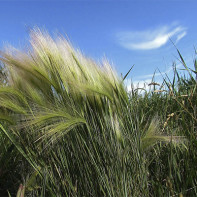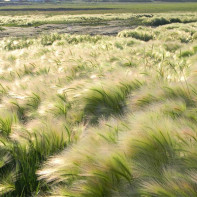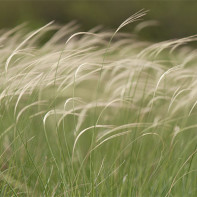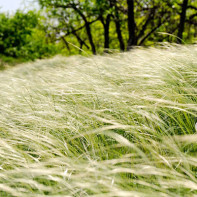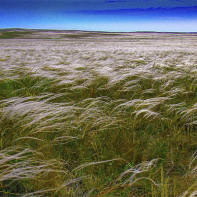Mullein: medicinal properties and contraindications
Many people are well aware of the rippling in the wind, like green waves, tall shiny attractive grass with beautiful hairy spikelets - feather grass. It belongs to the cereal family.
- Chemical composition
- How it looks and where it grows
- Types
- Gathering and storage
- Therapeutic properties of wormwood
- Feather grass in folk medicine
- For goiter treatment
- From paralysis
- Milk broth for paralysis
- From sciatica
- From joint pain
- For adenoma of the prostate
- Sleep disturbances
- From stomatitis
- Kinds of medicinal compositions
- Infusion
- Infusion
- Decoction
- Contraindications to use
Chemical Composition
Since the official medicine doesn't use the feather grass, the scientists didn't go deep into the chemical composition of the herb. Nowadays, it has only been determined that at the height of flowering the grass consists of more than 35% fiber. It also has protein protein, with a share of about 10.8%, and a little fat, about 2.7%.
Botanists note the presence of cyanogens such as trigloquinin in the leaves. Cyanogenic compounds contain hydrocyanic acid, so in large enough doses they are poisonous, in small quantities can have a sedative and analgesic effect on the body.
What it looks like and where it grows
Mullein is a perennial herb of a very distinctive appearance with narrow, long leaves that are flexible and also stiff, wire-like, as they are quite often twisted into a tube.
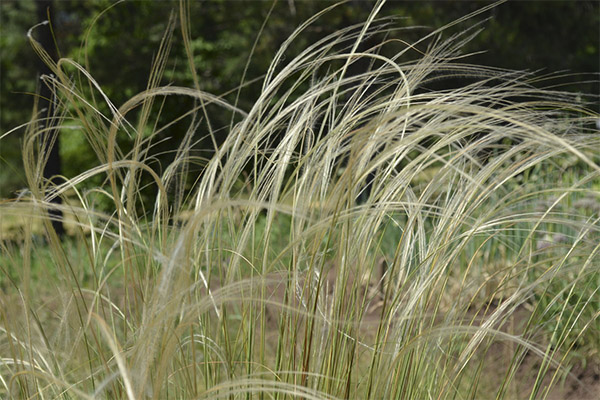
Above the leaves rise inflorescences in the form of a lush panicle, gathered from several spikelets, rising a meter above the ground. Bagasse begins to flower in late May or early June. Each spike in the inflorescence is single-flowered, with a pair of covering scales. Each ear holds a seed which rests in its bed till it matures, thanks to a long beautiful awn that looks like a pinnate "hair" and falls off after the ear ripening.
The spikelets are so sharp that they inflict serious wounds on the tongue of animals that decide to bite into the feathery worm. Pustules and non-healing fistulas form on the mucous membranes of the animals' mouths; this condition has even been called fever disease, which often leads to death. Hence the second name of the fever is sheep's death. Therefore, despite its rather high nutritional value, it is not recommended to feed animals with feather grass, and if it is still used for fodder purposes, only in May, before flowering.
Mullein is characterized by the weak development of the root system. Its rhizome is short and cannot hold on to the dense and strong soddy meadow soil. But as soon as sod weakens for any reason and loses its fertility, for example, because of the long absence of rains, after the burning of dry grass in spring, it quickly takes over the territory as a real aggressor. It grows in groups, mounds, whole turfgrasses.
Feather grass is mostly a steppe plant, preferring poor soils, it is wind- and drought-resistant. It can also settle on dry hills and stones at the foot of cliffs. Its vast locations occupying the virgin lands of Kazakhstan are very beautiful. The vast expanses of Donetsk and Kherson regions of Ukraine are particularly rich in feather grass. In Western European countries the grass occupies large dry areas in Spain and Hungary. In Russia, the main place of growth of the grass is the southern Siberian regions, the middle Urals and Transbaikalia, in Asia - the semi-desert areas of the Gobi desert, Mongolia and China, as well as areas of the Azov and Caspian Sea basins. Separate varieties are found in northern Africa - in a number of Moroccan and Algerian regions.
As soon as night falls on the steppe where feather grass grows, the air becomes cooler and plants are covered with dew, the curled leaves begin to straighten, cease their rigidity and elasticity and curl toward the ground so that the panicle inflorescence rests on the ground.
With the first rays of the sun, the dew slowly dries out, and the grass straightens up. But the seeds remain on the ground, which give life to new plants after it rains.
Due to its effectiveness, beauty and undemanding soils, feather-grass became a favorite of flower growers and "moved" to homestead plots. Some of its varieties were actively used by landscape designers to decorate territories.
Species
Mulberry is a plant richly represented by all kinds of varieties. Biologists today count about 300 of its species, in Russia you can see 80 of them. Russian "residents" are the Zalessky's feathery, pinnate, hairy-leaved, finest, magnificent, most beautiful.
Zalessky's feather-grass, except in the southern Urals, Siberia, the southern regions of the European part of Russia, is found on steppe and stony soils of Europe and China. It has smooth stems that do not grow taller than 70 cm, and the leaf tube is broad and loose.
It is characterized by slightly roughened leaves and light pubescence covering the stalks of its brownish inflorescences. Its arrows, which resemble a bird's feather (hence the name of the species), can reach a height of 30 cm to 1 m, while the inflorescences reach a length of 25 cm. The narrow leaves are rolled up into tight, dense tubes. Such a feather-grass is increasingly becoming a guest on homestead plots, and gardeners decorate their flower beds with it.
The leaves of the most beautiful feather-grass are distinguished by the presence of a large number of branches, at the base of which the down is clearly visible. Its lower leaves are darker than the upper ones, and the panicles of its inflorescences are reddish, not wide, as if compressed, and covered with small hairs. This species of feather-grass prefers to climb rocks and mountain plateaus, where it survives well in calcareous rocks. But it is found less and less often in recent years.
The fine feather-grass is characterized by stiff leaves and sturdy stems about 70 cm high. The lilac-purple panicles do not grow larger than 20 cm. Unlike its relatives, it likes fertile black earth soils. It is native to Mexico and does not occur often in nature, but it is quite actively grown in flower gardens.
Feather-grass, or hairy-leafed Mullein, as it is nicknamed by people, is not a very large plant, up to 60 cm, with leaves of a green-grayish-gray color. Both flowers and awns are covered with hairs.
The bushes of the magnificent featherbed reach a height of 75 cm. The width of the leaves is about 7 mm. By self-sowing, it flooded the rocky mountain slopes of the Ural Mountains and the Altai.
A rare species is the gravelly feather-grass feather-grass. It is native to the mountainous regions of Tibet, Afghanistan, Pamir and Tien Shan. It is not very tall, up to 40 cm, and its leaves stick out from the sod like stubble. But the panicle inflorescences surprise with beautiful long pubescent hairs. Its closest relatives, which are very similar, also live in mountainous areas - Caucasian feather grass and Lessing's feather grass. The first has taken root in the foothills of the Caucasus, the second in the European subtropics.
There are species that grow in limited regions, and their name speaks for itself. For example, there is the Ukrainian feather grass, which is found in the steppes near the Black Sea, in the Krasnodar and Stavropol regions. It is the smallest species, never taller than half a meter, its panicle is small and nondescript. It is a rare species and is protected under the laws of Russia and Ukraine.
It grows in China, Japan and the far easternmost regions of Russia. It is a giant! It often grows up to 180 cm tall and has long panicles and 50 cm long stringy hairs. The leaves are as big as the other varieties and can be up to 3 cm wide.
With all the great species diversity, this aggressor is also losing its position: its natural populations have been declining in recent years due to the development of fallow lands by agricultural producers. Therefore, many species of the plant are listed in the Red Book as endangered.
Collection and storage
Folk medicine has learned to prepare medicinal remedies from all parts of the plant - roots, leaves with stems, seeds and stump.
In medicinal applications the green part of the feather grass is harvested in the last week of May or in early June, when it is flowering. Cut it as close to the ground as possible. It should be done in dry weather, not necessarily sunny, the main thing is that the grass shouldn't be wet because of dew or rain. Dry the harvested material in a shaded spot out of reach of sunlight and well-ventilated. You can build a hammock of mesh with small cells and place the grass on this "bed" - so it will be aired from all sides.
Roots are dug out in the fall, washed and, like herbs, dried in a draught, where there is no access to the sun.
Grind the raw material at a convenient time. After drying, it is immediately ground in a coffee grinder (but not to a powder, but about the size of a tea) and packed in paper bags or cotton sacks. You can store the raw material as a whole, and crumble it just before brewing.
Store dried humus in a dark, dry room or closet in a regular room. In such conditions it will retain its healing properties for two years.
Therapeutic properties of knotweed
Despite the fact that there are many species of feather-grass, only one of them - pinnate - has medicinal properties. Folk healers have noticed that this plant gives a good result in the treatment of a number of ailments, in particular diseases of the thyroid gland, as well as multiple sclerosis and paralysis, especially one-sided post-stroke. The plant is also effective for rheumatic and radiculitis pains, for prostatic adenoma relief thanks to its ability to improve blood flow and remove inflammation. The anti-inflammatory ability of the mullein is also the basis of its prescription by healers for the treatment of mucous membrane problems.
The cyanogens in herbs give herbal remedies a calming and analgesic effect, so they are recommended in cases where you need to relieve pain, tension or fatigue, to calm the nerves and relieve stress.
Rudder in folk medicine
For centuries, folk medicine has used the whole plant - both the leaves and the roots and seeds. They are used to make infusions, extracts and decoctions, which are then taken internally and used for poultices, compresses and lotions. But especially valuable are considered to be compositions from the leaves. And wormwood can be used alone or as part of herbal mixtures.
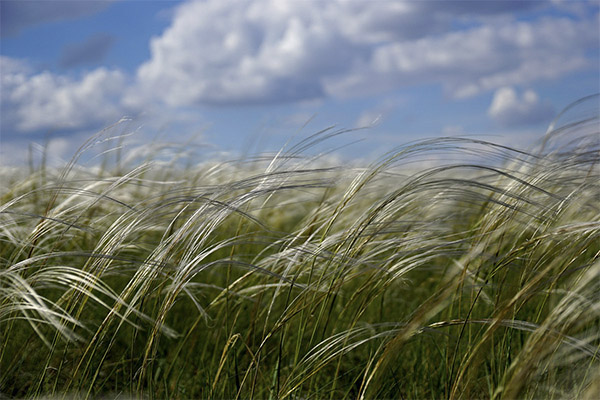
For goiter treatment
Goiter appears as a result of an increase in the thyroid gland. To prepare a remedy for getting rid of this problem, you need to make a milk broth: boil for 5 minutes in 250 ml of milk 2 teaspoons of dried crushed grass marigold, let the composition to infuse for 30 minutes. After straining, drink the decoction in small sips, stretching the resulting portion for the day. You can soak a gauze napkin in it, put it on the area of the thyroid gland as a bandage, cover with plastic wrap and quietly lie down for 30-40 minutes.
From paralysis
To reduce the manifestations of paralysis, you need to make a herbal collection, in which to mix taken in equal parts mordant grass seeds and dry ground raw materials of feather grass. Pour 2 teaspoons of the mixture of medicinal plants in a thermos, fill it with a glass of boiling water and leave it for the night. If there is no thermos, you can cover the container with the composition with a lid and wrap with a woolen scarf. Also leave it to insist overnight. In the morning, filter the infusion, the resulting volume is the norm of medicine for the day. Drink in small sips. In this recipe, mullein acts as an enhancer of the action of mordowberry, a recognized remedy that allows a quick recovery from a stroke. It is possible to buy mordovnik in a drugstore.
Milk decoction for paralysis
In a glass of milk brought to a boil, pour a tablespoon of dried raw material marigold. Over low heat to boil the composition for 15 minutes, then infuse another hour under a closed lid. Strain and drink a tablespoon before sitting down to breakfast, lunch or dinner. Alternate every other day this milk decoction with a decoction made with water.
For sciatica.
Alcohol-based remedies are used to treat sciatica, rheumatism, and inflammation in the joints. A teaspoon of a medicinal collection made from dried raw material with seeds of mordantrope, taken in equal parts, pour 100 ml of alcohol and insist 20-25 days at 22-25 degrees in a dark place - for example, in a closet. Stretch with this composition of the painful joints.
For joint pain
Boil 2-3 handfuls of crushed mullet in 200 ml of water for 5-10 minutes and leave to steep the medicinal raw material. When the composition becomes warm, strain the herb and apply it in the form of an application to the affected joints. Cover with plastic wrap and wrap with a warm woolen scarf for half an hour.
For adenoma of the prostate
Mix in equal proportions of the herbs of the herbs of the herbs of the feather grass and horsetail. Take 150 grams of the mixture (this is about 3 handfuls) and bring them to a boil in 3 liters of water. Then insist for an hour. After straining, use the liquid to prepare a bath: pour it into a basin, add 3-4 more liters of water and sit in it. Duration of the procedure - 30 minutes, it is better to perform it at night, before going to bed, for 7-10 days. For faster treatment, you can combine the reception of such a bath with a chamomile enema, which is done an hour and a half before the bath. After the procedure, do not walk around the house and do not cool the body, but rather cover yourself with a blanket for warmth.
Sleep disturbances.
If due to any stressful situations at work, worries and overstimulation of the nervous system sleep is disturbed, it is recommended to take at night an infusion of herb of mat-grass mixed with mint. Pour a teaspoon of peppermint and half a teaspoon of matula in 300 ml of boiling water and leave for 15-20 minutes. When it is infused, drink it with a spoon of honey and go to bed. Before brewing, you can add to a container with herbs half a ring of lemon or a drop of lemon peel. The pleasure of wonderful taste and smell, and a restful sleep is guaranteed!
For stomatitis
Soothe pain in the mucous membranes and relieve redness and inflammation, you can use milk decoction of mugwort. Pour a teaspoon of dried medicinal raw materials with half a cup of milk brought to the boil and leave it to infuse for about an hour and a half. With a cotton swab gently, trying not to hurt, smear the mouth redness and ulcers until recovery.
Types of medicinal compositions
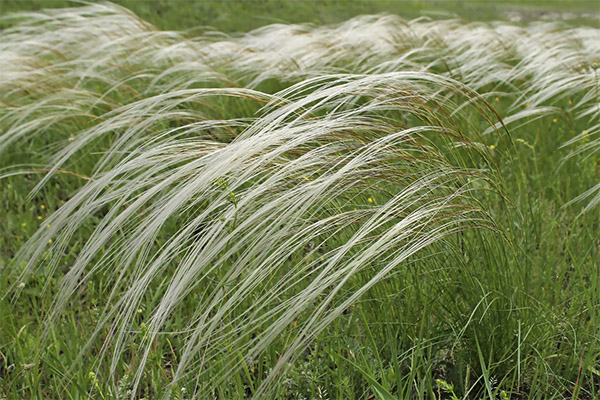
Infusion
A variant on water.
To alleviate the symptoms of paralysis, you can prepare a water infusion of matlicker and replace the usual tea drinking with it. It should be brewed from the roots of the healing plant, any - both fresh and dried - are suitable. Take 4 tablespoons of medicinal raw materials per liter of boiling water. Pour the liquid roots, cover and insist for about 2 hours. Before using the cooled composition dilute with hot water.
You can eat a spoonful of honey or jam with the broth, it is acceptable to put sugar in a cup.
Variant with milk
In the evening, steep in a thermos of hot milk 2 tablespoons of crushed dried leaves of a feather mat. Insist a whole night, by the morning will be ready a daily portion of the healing composition, which can treat the thyroid gland and goiter. Strain the remedy, the liquid to drink in small sips. Boiled herb is perfect for lotions, which are put on the neck in the area of the thyroid gland.
Tincture .
To treat sciatica and rheumatism take half a teaspoon each of dried raw material of mullein and hawthorn seeds, pour into a dark glass container, pour there the same 100 ml of alcohol. Insist 3 weeks composition in a place inaccessible to the sun. At the end of this period, strain the tincture and rub it aching joints, pulled muscles. In addition, for a more rapid relief of suffering, you can drop 20 drops of tincture in a glass, dilute it with 50-70 ml of water and drink in the morning and evening after a meal.
If for the same volume of alcohol to take not half, but a whole teaspoon of herbs, the tincture will be richer. You can rub with it not only for rheumatism, but also for multiple sclerosis. But you should not take the composition inside in such a concentration.
Decoction
With milk
To speed up recovery and reduce the time of rehabilitation after a stroke, folk healers recommend decoction on milk. The same remedy will help in the treatment of paralysis.
Bring to a boil 2 cups of fresh milk and put in it 2 tablespoons of dried leaves of the feather mat. Over low heat to boil for 15-20 minutes, then insist another hour. Strain the composition, the liquid to divide equally over two days and drink in small sips.
The remaining cake can be used for compresses and lotions.
Water
Such a composition can also be used to alleviate paralysis or after a stroke. Take a glass of water, in which bring to a boil a large spoonful of the medicinal plant. Boil for 15 minutes and infuse for an hour. After straining, you can drink the resulting liquid. If you soften it by pouring a little milk, as in an ordinary tea, and the taste will be more pleasant, and the therapeutic effect will be more noticeable. Take such a decoction twice a day - before breakfast and dinner.
Contraindications for use
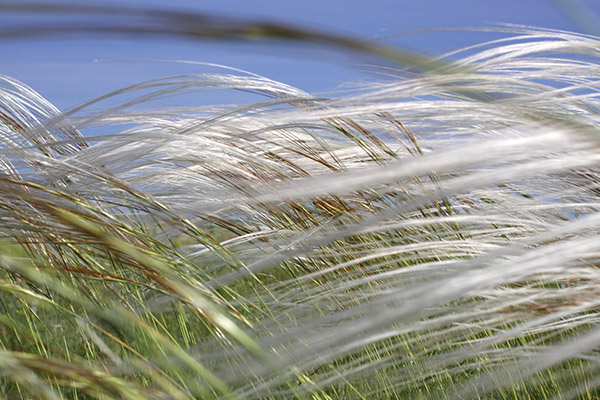
People who suffer from allergies should be very careful with matadha. Not only healing compositions based on this medicinal plant, but even a beautiful bouquet of inflorescences-blossoms used to decorate the interior, can provoke an asthmatic attack. When using compresses, lotions and rubs, allergies can manifest as redness of the skin and a rash.
Pregnant women and mothers breastfeeding babies are not recommended to use products made from feather pitch, as it is impossible to predict what effect they will have on the baby.
Even if the patient is not allergic, when preparing and ingesting compositions of fever pitch, you must be on guard, flawlessly follow the recommended proportions and in no case exceed the concentration. Otherwise, you may be poisoned. Its symptoms are: dizziness, nausea, cutting pain in the abdomen, severe weakness.
Before you decide on your own to start treatment with compositions based on the basis of the feather mat, it is necessary to talk to a doctor and listen to his recommendations on this matter.
«Important: All the information on the site is provided solely for introductory purposes. Before applying any recommendations, seek advice from a specialist. health care professional prior to using any of the recommendations. Neither the editors nor the authors shall be held liable for any possible harm caused by materials."

